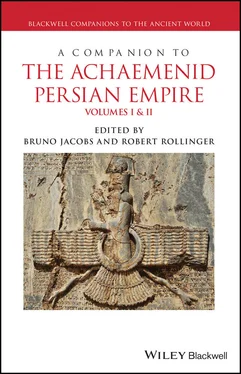Millions of years of erosion of the folded mountain chains throughout the Achaemenid Empire, supplemented by ongoing alluviation, resulted in the infilling of numerous plains and plateaus, and the creation of large salt basins like the Dasht‐e Lut and Dasht‐e Kavir in Iran. True deserts like the African Sahara or the Arabian Rub’ al‐Khali generally lay outside the bounds of the empire, except in Libya, but gravel plains are particularly prevalent in the eastern reaches of the Achaemenid Empire. Nor were these generally mediated by appreciable rainfall, though it is clear that precipitation varied enormously across the length and breadth of the region controlled by the Achaemenids. This is scarcely to be wondered at in an empire spanning so many degrees of latitude and longitude. From the Indo‐Iranian borderlands to Libya, and from the Caucasus to Oman, an enormous range of ecosystems existed within the borders of the Achaemenid Empire (Wilkinson 2003).
Generally speaking, the climate of most of the empire may be characterized as a drier, continental variant of the Mediterranean regime (Brice 1966: p. 36). Rainfall across most of the Achaemenid Empire fell in winter, the exceptions being in parts of Central Asia (Choresmia, Sogdiana), the Indo‐Iranian borderlands (Sattagydia, India), the Caucasus (Armenia), and Egypt, where summer rains, influenced in the southern districts by the monsoon, were the norm. Pockets of territory in central Anatolia, around Lakes Van and Urmia, the central Iranian plateau, Sistan, and Afghanistan received rain in both seasons (Brice 1966: Fig. 9). Just as it has been in recent times (Kouchoukos et al. 1998: p. 480), inter‐annual variability in precipitation was probably great. Hyper‐arid zones may have received only a few dozen millimeters of rainfall each year, while sub‐tropical areas like Gilan and Mazanderan received enough rainfall to enable double‐cropping (e.g. growing rice in summer and wheat/barley in winter). To cite just one extreme, modern example of inter‐annual variability, unusually heavy rainfall in 1968 saw the level of Lake Urmia rise by no less than 2 m. (Bottema 1986: p. 243). Fluctuations of this sort are generally not recorded in ancient sources, with the exception of the Babylonian astronomical diaries. In addition to containing observations on the height of the Euphrates (Slotsky 1997: pp. 88–98), these mention a wide range of meteorological phenomena, including rain showers, lightning, thunder, and tornados (e.g. Sachs and Hunger 1988: p. 71, no. 384) that characterized the Babylonian winter of 384 BCE.
With every type of environment from the sub‐tropical in the north to the semi‐arid steppe, arid desert, and humid coasts along the Persian Gulf and Arabian Sea in the south, Iran itself is a microcosm – if one can use such a term to describe an area three times the size of France – of the diverse range of ecosystems found across the empire. In the higher ranges of the Zagros mountains, where peaks in excess of 3000 m. above sea level can be found, heavy snowfall, perennial streams, and abundant springflow are well‐attested, while on the borders of Khuzestan, Sistan, Kerman, and Baluchistan, arid conditions exist in which dry‐farming is impossible without the aid of irrigation. The northerly winds of the summer, coming almost entirely from the north, cause the region to become overheated. Extreme examples, such as the 120 days' wind in Sistan (Drangiana) or the shamal in Mesopotamia (Assyria, Babylonia) and the Gulf region (the satrapy of the Erythraean Sea and Maka), while useful for sailors, are inhibitors of agricultural development. Still, in coastal areas where agriculture was unviable except in winter, fishing and pearling, not to mention trading, were pursued in summer. Living with drought in the more southerly satrapies of the empire would have been the norm for six months of the year whereas in the more temperate latitudes a far more Mediterranean climate was conducive to continuous agricultural production, punctuated by severe winters with heavy frosts and snowfalls, rather than hyper‐arid summers.
Climate and topography necessarily had an enormous influence on flora and fauna throughout the Achaemenid Empire. Once again, given its size, it is scarcely surprising that the empire spanned the Mediterranean, Euro‐Siberian, western and central Asiatic, and Saharan‐Indian floristic zones. The more central portions of the empire contained an enormous range of flora, including desert, steppe, and semi‐desert vegetation; sub‐tropical savannah; Pistacia and Quercus woodlands; scrublands dominated by almond and juniper; conifer forests; and sub‐alpine and alpine vegetation (Breckle 2007). Following the last glaciation the Zagros and Alburz mountains in Iran and the Hindu Kush/northern Afghanistan provided refuge for a large number of tree species, many of which later spread across Iran, Anatolia, and into Europe. Indications of ancient environments within the Achaemenid Empire are provided by both Achaemenid epigraphic and Greek literary sources as well as archeological data.
One of the most well‐known Achaemenid sources is Darius' exposition (DSf) of the materials used in the construction of his palace at Susa (Lecoq 1997: pp. 234–237). According to Darius, the cedar used in the palace came from the mountains of Lebanon; the sissoo wood (OP yakâ ; see Gershevitch 1957) from Gandhara (northwest Pakistan) and Kerman (southeastern Iran); and the ebony ( Dalbergia melanoxylon ) from Egypt. In ancient usage, however, it is often the case that the geographical descriptor attached to a commodity is the supplier of the material rather than the actual land in which it grew or was mined. This is true in the case of Darius' ebony, the actual provenance of which was probably somewhere in sub‐Saharan Africa (the current range extends from Senegal in the west to Eritrea/northern Ethiopia in the east and to Angola and the Transvaal in the south; see Hepper 1996: p. 6).
Minerals used in the palace at Susa included gold from Lydia, probably the alluvial gold of the Pactolus river (Muhly 1983: p. 7) or the slopes of nearby Mt. Tmolus (Forbes 1939: p. 244), and Bactria (northern Afghanistan and southern Uzbekistan); lapis lazuli and carnelian (?) from Sogdia; and turquoise from Chorasmia. It is doubtful whether the lapis lazuli mines at Sar‐e Sang in the Hindu Kush mountains of northern Afghanistan, the major source in all periods of ancient Near Eastern history, lay within the bounds of Sogdia, which centered on the Ferghana Valley further north in what today is Uzbekistan. Herzfeld reckoned the mines were located in eastern Bactria (Herzfeld 1968: p. 323). It is perfectly reasonable to suppose, however, that the Sogdians had access to lapis lazuli from Sar‐e Sang, though not that they necessarily controlled its extraction as has sometimes been assumed (La Vaissière 2004: p. 22). It is also questionable whether high‐quality carnelian was available anywhere in Sogdia and more likely that if carnelian is indeed the correct translation of the term in question (OP sinkabru , El. sinkabruš , Akk. Ṣingabrû ), it came from Gujarat (La Vaissière 2004: p. 21). Herzfeld suggested that carnelian was not meant here at all. Rather, he drew a parallel between the ancient term and cinnabar and suggested that this was “used for making the colours of the enamelled bricks of Susa” (Herzfeld 1968: p. 323, no. 3). As Pliny noted ( Nat. Hist . 29.8), cinnabar (Gr. κιννάβαρι) or mercuric sulfate (HgS), was often confused in antiquity with minium , or lead oxide (Pb 3O 4), which was indeed a source of red pigment (Theophrastus, De Lapidibus 8.60; Eichholz 1965: p. 128). Although in the Roman and medieval periods lead oxide came mainly from Spain (Porter and Vesel 1993: p. 147; cf. Strabo, Geog . 12.2.10, where the Iberian is said to rival the Cappadocian variety), another source must have been available to the Achaemenids, for analyses of glazed bricks in the Louvre, presumably originating in Darius' palace or one of the later royal Achaemenid buildings at the site (Boucharlat 2010: pp. 374–384), have shown the presence of lead oxide (Bouquillon et al. 2007: pp. 132–134). Interestingly, mercury was detected in some of the bricks in the so‐called Šāhūr palace of Artaxerxes II at Susa and this implies a source of cinnabar from which mercury was obtained (Boucharlat 2010: p. 408). The Chorasmian turquoise cited by Darius most probably came from the mines in the Kyzyl Kum, southeast of the Aral Sea and north of Zerafshan (Tosi 1974: pp. 149–150).
Читать дальше












